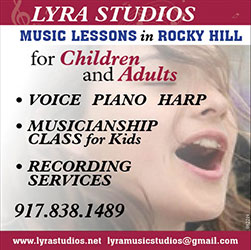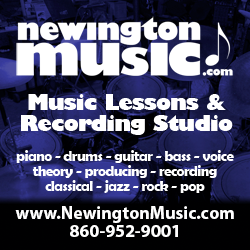

Jazz Pianist Fred Simmons electrifies a full-house audience at Wesleyan University’s Russell House Oct. 11. Photo: Dortha Cool Willetts.
Jazz Great Fred Simmons Mesmerizes
MIDDLETOWN - His long, narrow fingers flew over the piano keys, touched the high keys, then scrolled in an unbelievable arpeggio back down to pound out deep, resonant bass chords in impressive succession. His total immersion was breathtaking; his skill, stunning. This was what I and a full house of listeners were able to witness at a Russell House concert Sunday, Oct. 11. The concert, â€Ĺ"Fred Simmons: Turn of the Century,” was sponsored by Wesleyan University’s Center for the Arts and Russell House.Simmons was joined in his performance by famed vibraphonist Jay Hoggard, named just last month as Middletown’s Music Ambassador. Hoggard sometimes accompanied Simmons on the songs and at other times led with the melody. His mallets skedaddled over the bars so fast that his hands were a blur to the audience and to my camera. These were two jazz percussion masters who shared the passion of their music.
As two members of the audience, Paul and Caron of Durham, put it, â€Ĺ"The instrumentalists had a great conversation.”
Other concert goers had enthusiastic compliments. Karen and James Bendzenski were amazed by Simmons’ improvisatory skill.
â€Ĺ"He has so much energy in his hands, I don’t know how he gets it all out. It gave us such joy to hear the rolling sounds of his music,” said Karen.
Tom Dest of Wethersfield said he had heard one of the world’s most exceptionally gifted vibraphonists, Bobby Hutcherson, and thought that Hoggard â€Ĺ"is equal in talent to Hutcherson.”
Joyce Lowrie, a professor of Romance Languages at Wesleyan, gave the two a heartfelt compliment, â€Ĺ"This was one of the most exciting concerts of jazz I’ve heard in ages!”
The list of songs Simmons and Hoggard played, at times solo and then jointly, were: â€Ĺ"Fred’s Song,” written by Simmons; â€Ĺ"Triste” by Carlos Jobim; â€Ĺ"And then Again,” by Simmons; â€Ĺ"In a Sentimental Mood” and â€Ĺ"Take the A Train,” by Duke Ellington; Thelonious Monk’s â€Ĺ"Brilliant Corners;” John Coltrane’s â€Ĺ"Moment’s Notice;” Simmons’ â€Ĺ"Going Forth;” and â€Ĺ"Manteca,” by Dizzy Gillespie.
Simmons, a jazz piano teacher at Wesleyan University for many years, said he started with the drums, then moved to piano. Born in Philadelphia, he and his quartet played a free concert at the Free Library of Philadelphia’s Central Branch in 1991, reported Bill Kent of The Inquirer. He quoted Simmons, remembering, â€Ĺ"I used to go up on the roof; you could sit up there with some books and feel peaceful. I never thought I’d be playing the same place.”
Raised by his grandmother, who had a little storefront â€Ĺ"holy roller” church, Simmons said, â€Ĺ"With me, and most of the guys coming out of Philadelphia, it started in the church.”
But he was just a few blocks from some of the best jazz clubs in the city.
â€Ĺ"Back then, you got your education by sitting in,” he said. â€Ĺ"Every club had a piano, and if you were polite about it, you could find out how you wanted to play and there was an audience to appreciate it.”
At home, Simmons listened to whatever records he could find and try to copy what he heard on the piano. His early influences were Philly Joe Jones, Red Garland, Coltrane and Miles Davis.
In the late ‘60s, after touring most of Europe and the United States, Simmons moved to New York, because, as he put it, â€Ĺ"Everybody said that you had to be in New York if anything big was going to happen to your career.”
In Philadelphia Simmons played with John Coltrane and in New York he recorded with Robin Keyatta, Rashied Ali and Dewey Redmon.
Simmons led a double life in the 80’s and 90‘s; Kent wrote that Simmons performed, practiced and wrote in Philadelphia on weekends and taught jazz piano, theory and composition at Wesleyan University in Connecticut on weekdays.
It was in New York, Simmons explained, that disco started taking over and jazz musicians began getting less work.
â€Ĺ"Many of the musicians went into the schools to get degrees and teach,” he said. â€Ĺ"It was a steady thing, and a way of keeping the music alive.”
Kent wrote, â€Ĺ"Simmons finds teaching a peculiar challenge because, although he attended the Ormstein School of Music locally [in Philadelphia] and Brooklyn College and Juilliard in New York, his jazz is self-taught.”
Simmons said that many students who would have gone into classical piano are now going into jazz. He said he has told them that playing jazz doesn’t make you much money, but â€Ĺ"if they can keep their needs simple, they can do what I’m doing, which is playing what I like to play.”
â€Ĺ"Teaching is very rewarding,” Kent quoted Simmons at the 1991 concert. â€Ĺ"You’re recapping everything you’ve done yourself. You can relate with students, and the students throw something back with you, and you start going into new directions. You can still create, but you don’t need to be locked into anything.”
Having had a seat directly in front of Simmons at the Russell House, I felt truly privileged to have heard and seen this remarkable jazz pianist create along with an equally remarkable vibraphonist.








